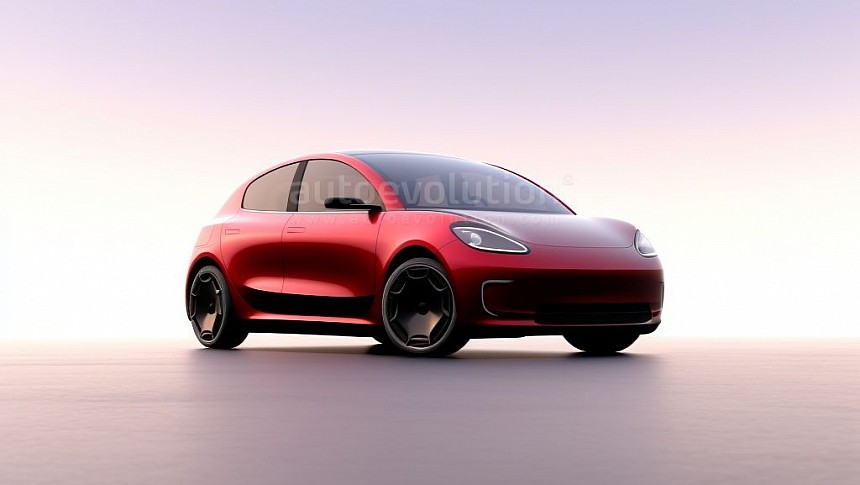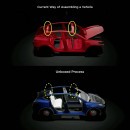When Tesla's sales face a dip or plateau, it often triggers speculation regarding the sustainability of its growth. Historically, Tesla has demonstrated the ability to rebound strongly within a quarter or two, showing remarkable sales figures that now put it firmly in first place in the global EV market. With that in mind, predicting a similar 'accelerated growth' pattern in the years ahead is more complicated.
Unsurprisingly, the carmaker operates in a highly dynamic EV market influenced by various factors, including competition, technological advancements, regulatory changes, and consumer preferences.
The electric vehicle market is evolving rapidly, and Tesla's future growth will depend on how it navigates this shifting landscape and continues to innovate, not only with its business strategy but with its vehicle lineup.
Elon Musk's vehicular pride and joy has one of the oldest lineups among its competitors despite being one of the newer carmakers in the game, as it was still considered a startup until a few years ago.
The Tesla Model S recently had its 13th anniversary, while the Model X has been on sale since 2015. A traditional automaker would have had at least one generation change in the same amount of time, while Tesla seems to try and milk the two models through facelifts OTA (Over The Air) updates for as long as possible.
Some will say that Henry Ford did something similar with the Ford Model T, which motorized America with the same shape for almost 19 years, except for the over-the-air updates, naturally.
The trouble with that line of thought is that we no longer live with the same rhythm as pre-war America. Things are changing at such a rapid pace regarding technology and trends that Tesla is quickly getting left behind with half its lineup.
In a bid to achieve its ambitious target of selling 1.8 million units in 2023, Tesla faces the daunting task of selling approximately 476,000 vehicles in the fourth quarter alone. The company has implemented price reductions across several of its highly popular models to stimulate sales and bolster demand several times, including yet another price cut made just a few days ago.
According to Tesla's strategy, this move aims to entice prospective buyers and potentially drive up sales figures, contributing to the carmaker's overall sales goal for the year.
We are, again, talking about an aging lineup in an ever-changing and expanding market, with more and more legacy and new automakers trying to dig into the same EV pie.
Even worse, Tesla's share of the electric vehicle market from January to August this year experienced a rather extensive decrease, dropping from 65.1% in the previous year to 58%. This decline obviously indicates a shift in the EV market landscape, with other competitors gaining traction and challenging Tesla's once-dominant position.
Nobody expected Model S and X sales to compete with the much less expensive Model Y and 3, which recently received the much-awaited 'Highland' facelift. That said, the two top-of-the-range models are now in the red regarding sales or desirability.
The carmaker is currently busy improving its battery and vehicle production lines and testing pre-production versions of the delayed Cybertruck and Tesla Semi. Still, neither will do much to improve its overall sales since we are discussing costly products at the high end of the mainstream market.
Industry analysts even gave it the 'Model 2' name, envisioning a compact hatchback of sorts to battle established EVs in this smaller and less expensive segment.
After a myriad of speculations and renderings on the subject in the last few years, there doesn't exist a consensus on what the car will be called or how it will look.
Indeed, creating an affordable EV is crucial for Tesla to solidify its position in the EV market or rebound to it if things continue to slow down even more in the next years. A more affordable Tesla could significantly expand the company's customer base and accelerate the adoption of electric cars globally.
It would make electric vehicles accessible to a broader demographic, a goal often emphasized by Elon Musk. The specific details and progress toward achieving it are eagerly anticipated by both enthusiasts and industry observers, but I'm not holding my breath.
I believe a true chess master move would be to include an even smaller and less expensive model in the lineup, something like Ford's Model T at the time. Something like a Model 1 (nameplate pending), with a $15,000 starting price, is not impossible to envision. If one carmaker can do it, it's probably Tesla.
On top of it, qualifying for the full $7,500 federal incentive would be a game-changer for Tesla. Meeting the latest federal incentive criteria, especially regarding North American battery component production and critical mineral sourcing, would halve the model's starting MSRP. In your driveway for as low as $7-8k would be groundbreaking, potentially revolutionizing the EV segment and the passenger car market in general.
The only issue is, can Tesla make a car that sells for around 15 grand and still make a profit? It's common knowledge that making a $100,000 car is way easier than making one that costs 15 percent of that and still earn money with it. For that, you need lots and lots of sales and a bullet-proof production system and supplier relationships, something which Tesla is already struggling with.
That said, it recently previewed its Gen-3 platform and is currently applying the finishing touches on groundbreaking its Nuevo Leon Giga factory in Mexico. The carmaker also let it slip that it plans to build up to 4 million units per year in three different factories from a yet-unnamed model.
Again, it would be Tesla's Ford Model T. Or, closer to our times, it would be Tesla's Dacia, the low-cost, European carmaker that builds the best-selling cars on the European market.
In other words, it's not impossible. Either way, Tesla needs to sort its aging lineup problem fast. The Cybertruck and the Roadster will not do enough to keep the lights on after so many investments in production instead of modernizing the products it sells.
The electric vehicle market is evolving rapidly, and Tesla's future growth will depend on how it navigates this shifting landscape and continues to innovate, not only with its business strategy but with its vehicle lineup.
Elon Musk's vehicular pride and joy has one of the oldest lineups among its competitors despite being one of the newer carmakers in the game, as it was still considered a startup until a few years ago.
The Tesla Model S recently had its 13th anniversary, while the Model X has been on sale since 2015. A traditional automaker would have had at least one generation change in the same amount of time, while Tesla seems to try and milk the two models through facelifts OTA (Over The Air) updates for as long as possible.
Some will say that Henry Ford did something similar with the Ford Model T, which motorized America with the same shape for almost 19 years, except for the over-the-air updates, naturally.
The trouble with that line of thought is that we no longer live with the same rhythm as pre-war America. Things are changing at such a rapid pace regarding technology and trends that Tesla is quickly getting left behind with half its lineup.
The Bigger They Grow, the Harder They Fall?
The Model Y is Tesla's best-seller and the world's highest-selling electric car. There are few reasons for this trend to continue, though.In a bid to achieve its ambitious target of selling 1.8 million units in 2023, Tesla faces the daunting task of selling approximately 476,000 vehicles in the fourth quarter alone. The company has implemented price reductions across several of its highly popular models to stimulate sales and bolster demand several times, including yet another price cut made just a few days ago.
According to Tesla's strategy, this move aims to entice prospective buyers and potentially drive up sales figures, contributing to the carmaker's overall sales goal for the year.
We are, again, talking about an aging lineup in an ever-changing and expanding market, with more and more legacy and new automakers trying to dig into the same EV pie.
Even worse, Tesla's share of the electric vehicle market from January to August this year experienced a rather extensive decrease, dropping from 65.1% in the previous year to 58%. This decline obviously indicates a shift in the EV market landscape, with other competitors gaining traction and challenging Tesla's once-dominant position.
Nobody expected Model S and X sales to compete with the much less expensive Model Y and 3, which recently received the much-awaited 'Highland' facelift. That said, the two top-of-the-range models are now in the red regarding sales or desirability.
The carmaker is currently busy improving its battery and vehicle production lines and testing pre-production versions of the delayed Cybertruck and Tesla Semi. Still, neither will do much to improve its overall sales since we are discussing costly products at the high end of the mainstream market.
Tesla's Bet With Mainstream Cars
Elon Musk has long discussed the goal of creating an affordable electric car, aiming for a vehicle priced around $25,000. However, specific details or updates regarding this goal were notably absent in Tesla's latest Master Plan outlined in 2023.Industry analysts even gave it the 'Model 2' name, envisioning a compact hatchback of sorts to battle established EVs in this smaller and less expensive segment.
After a myriad of speculations and renderings on the subject in the last few years, there doesn't exist a consensus on what the car will be called or how it will look.
Indeed, creating an affordable EV is crucial for Tesla to solidify its position in the EV market or rebound to it if things continue to slow down even more in the next years. A more affordable Tesla could significantly expand the company's customer base and accelerate the adoption of electric cars globally.
It would make electric vehicles accessible to a broader demographic, a goal often emphasized by Elon Musk. The specific details and progress toward achieving it are eagerly anticipated by both enthusiasts and industry observers, but I'm not holding my breath.
I believe a true chess master move would be to include an even smaller and less expensive model in the lineup, something like Ford's Model T at the time. Something like a Model 1 (nameplate pending), with a $15,000 starting price, is not impossible to envision. If one carmaker can do it, it's probably Tesla.
On top of it, qualifying for the full $7,500 federal incentive would be a game-changer for Tesla. Meeting the latest federal incentive criteria, especially regarding North American battery component production and critical mineral sourcing, would halve the model's starting MSRP. In your driveway for as low as $7-8k would be groundbreaking, potentially revolutionizing the EV segment and the passenger car market in general.
The only issue is, can Tesla make a car that sells for around 15 grand and still make a profit? It's common knowledge that making a $100,000 car is way easier than making one that costs 15 percent of that and still earn money with it. For that, you need lots and lots of sales and a bullet-proof production system and supplier relationships, something which Tesla is already struggling with.
That said, it recently previewed its Gen-3 platform and is currently applying the finishing touches on groundbreaking its Nuevo Leon Giga factory in Mexico. The carmaker also let it slip that it plans to build up to 4 million units per year in three different factories from a yet-unnamed model.
Again, it would be Tesla's Ford Model T. Or, closer to our times, it would be Tesla's Dacia, the low-cost, European carmaker that builds the best-selling cars on the European market.
In other words, it's not impossible. Either way, Tesla needs to sort its aging lineup problem fast. The Cybertruck and the Roadster will not do enough to keep the lights on after so many investments in production instead of modernizing the products it sells.








